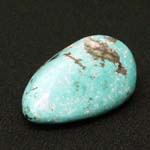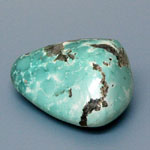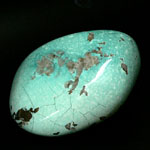Stone, minerals and semiprecious of the world stone
Phosphate: Turquoise -->rus
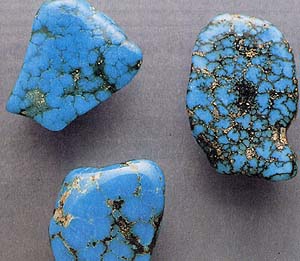 Diagnostic cart.
Diagnostic cart.
Cu Al6 (PO4)4 (OH)8 * 4 H2O
Crystal structure triclinic
Hardness on the Mohs scale 5-6
Specific unit weight mass 2,6-2,8
Cleavage noperfect absolute
Fracture, break padman
Colors greenish-blue
Colors in powder triturate bluish (cyan)-white
Glance (glitter, glare) from waxen to mother-of-pearl
A word "turquoise" originates from the Persian words - "piruze", "firuze" is victory, winner. The synonym of "kallaite" (по-Greek. beautiful stone) is less known. Crystals: shallow, very rare; usually botryoidal and kidney-shaped reniform aggregates, thin veins. Were first found out crystals in Nativeia (USA) in 1911, to this mineral considered amorphous. On a fresh fracture brilliance of glassy or waxen.
An attractive azure sky-blue color is replaced at 250oC unattractive green (requires a carefulness at soldering of wares!). Colouring deteriorates also under influence of sunlight, Cosmetology, sweat and butters (rings with turquoise it is better to take off at washing of hands!), equal as at large dryness of air. A polish strengthens colouring. An impregnation in an oily or paraffin bath-house or treatment the special plastic is instrumental in the increase of hardness of mineral due to corking of pores. The clean blue colouring is rare, more frequent turquoise is pierced brown (Limonite) or black (Psilomelan) veins: so-called "turquoise matrix" or "reticulated turquoise". Accretions of turquoise are known also with malachite and chrysocolla.
Turquoise be found as dense the masses, executing cracks, and also botryoidal and kidney-shaped reniform excretions, raids and tumours. Turquoise veins arrive at on power 2 sm of Deposit of minefield mine field occurrence subsoil turquoise of the best quality known in north-eastern Iran (near Nishapura is Persian turquoise). There are deposits in Afghanistan, East Australia, China (Tibet), Israel (to the north Eylata), Tanzania, on the south-west of the USA and in the CIS (Middle Asia, Caucasus - CIS).
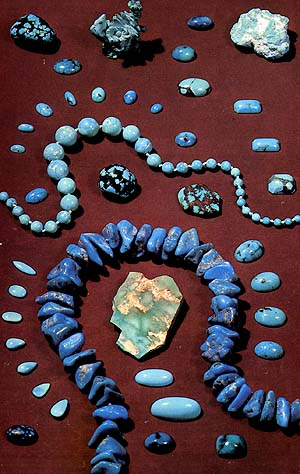 Chemical composition (chemistry, compound) is inconstant. In the process of senescence and at a substitution the second minerals the role of oxydic iron, silica, calcium, magnesium, zinc, strontium increases. Chemical composition (chemistry, compound) (in %): CuO - 9. 57, Al2O3 - 36,84, Pb2O3 - 34,12, H2O - 19,47. Permanent admixtures - Sulphur, Sulfur, Brimstone, zinc, barium, chrome, nickel, titan and other
Chemical composition (chemistry, compound) is inconstant. In the process of senescence and at a substitution the second minerals the role of oxydic iron, silica, calcium, magnesium, zinc, strontium increases. Chemical composition (chemistry, compound) (in %): CuO - 9. 57, Al2O3 - 36,84, Pb2O3 - 34,12, H2O - 19,47. Permanent admixtures - Sulphur, Sulfur, Brimstone, zinc, barium, chrome, nickel, titan and other
Microcrystalline the masses of kidney-shaped reniform form are ordinary or as crusts, streaks and wrong form of accumulations. Hardness on the Mohs scale goes down to 2-4 at efflorescent standards, fragile. In dense copies, 2,6 g/sm3 in efflorescent. Turquoise often be found as rounded concretion - nodula.
Dispersion: strong. Blue turquoise is characteristic for untouched weathering turquoise, depends on maintenance of copper. Greenish, brown and other tones are conditioned oxydic iron, substituting for a copper in the area of its intensive decomposition. Admixture of halloysite, kaolinite and wavellite give whitish spots. Often turquoise contains inclusion quartz, Pyrite and other minerals.
Always opaque, only sometimes translucent on edges, it has the homogeneous blue colouring. But there are branching out brown or black veins of swamp ore in the most widespread varieties. Transparent crystals are the rarest cases. Almost always turquoise be found as rounded concretion or massive accumulations of microcrystalline structure and kidney-shaped reniform form; can form veins into containing rocks. Due to the porosity turquoise is easily exposed to the second changes, to changing its natural colouring. Therefore it is sometimes necessary to process it inclusion by the special protective facilities.
Diagnostic indication.
At heating in a glass kimberlite tube turquoise loses water and becomes brown or black. In addition, it not melt fuse in flame of candle and does not paint flame in a green color, that distinguishes it from imitations. In middle ages the Persian merchants transported turquoise in jugs with water.
Porosity of mineral allows artificial synthetic ly to tint his aniline dyes and salts of copper. Imitate turquoise by painted chalcedony, howlite, crumb of turquoise, "sintered" with adhesive, pasting mass, and also glass, porcelain or synthetic resins. Synthetic imitations meet at the market of jeweller stone under the names "Hamburg turquoise", "neolith" and "neoturquoise". Entangling turquoise is possible with amatrikse, by an amazon-stone, chrysocolla, calamine, hemimorphite, lazurite, dental calculus, dental tartar, odontolith, serpentine, smithsonite, zinc spar, Variscite.
Origin provenance genesis.
Turquoise - mineral of the second origin. It appears as a result of circulation of mineralized solutions in the layer of siltages, mainly sandstones, or in volcanic rocks (trachyte - a light-coloured fine-grained volcanic rock of rough texture consisting of feldspars with small amounts of pyroxene or amphibole), as a rule, strongly fissured, cracked.
Deposit minefield mine field occurrence subsoil.
Classic deposit of turquoise, known from antiquity, - Ali-mirza-kukh near-by Nishapura (Iran). Found also on Sinae, in Kazakhstan and Uzbekistan. Beautiful on colouring of concretion Nevada, New Mexico and Arizona, is found in the states. The rarest transparent crystals acted from the state of Nativeium, from Belgium and from a peninsula Kornuoll. Developments of turquoise on the Sinayskom peninsula are most ancient from operating mineries. The booty of turquoise began there as early as 6000 B.C. Deposit of minefield mine field occurrence subsoil turquoise on the Sinayskom peninsula developed already for 4 millenniums B.C. At that time from turquoise did amulets, decorations, used it in Cosmetology.
Use is on jeweller business.
Turquoise is used on jeweller business, and also for making of intaglios and statuettes. Turquoise behaves to those semiprecious stone which counterfeit more frequent than all, replacing both natural and artificial synthetic materials.
